Android 14, geliştiriciler için harika özellikler ve API'ler sunuyor. Aşağıdaki yardım kaynakları, uygulamalarınızdaki özellikler hakkında bilgi edinmenize ve ilgili API'leri kullanmaya başlamanıza yardımcı olur.
Eklenen, değiştirilen ve kaldırılan API'lerin ayrıntılı listesi için API farklılıkları raporunu inceleyin. Eklenen API'lerle ilgili ayrıntılar için Android API referansını ziyaret edin. Android 14 için API düzeyi 34'te eklenen API'leri bulun. Platform değişikliklerinin uygulamalarınızı etkileyebileceği alanlar hakkında bilgi edinmek için Android 14'ü hedefleyen uygulamalarda ve tüm uygulamalarda Android 14 davranış değişikliklerini inceleyin.
Uluslararası hale getirme
Uygulamaya özgü dil tercihleri
Android 14, Android 13'te (API düzeyi 33) kullanıma sunulan uygulama başına dil özelliklerini aşağıdaki ek özelliklerle genişletir:
Uygulamanın
localeConfigdosyasını otomatik olarak oluşturma: Android Studio Giraffe Canary 7 ve AGP 8.1.0-alpha07'den itibaren uygulamanızı uygulama başına dil tercihlerini otomatik olarak destekleyecek şekilde yapılandırabilirsiniz. Android Gradle eklentisi, proje kaynaklarınızı temel alarakLocaleConfigdosyasını oluşturur ve nihai manifest dosyasına bu dosyaya referans ekler. Böylece artık dosyayı manuel olarak oluşturmanız veya güncellemeniz gerekmez. AGP,LocaleConfigdosyasına eklenecek yerel ayarları belirlemek için uygulama modüllerinizinresklasörlerindeki kaynakları ve kitaplık modülü bağımlılıklarını kullanır.Uygulamanın
localeConfigiçin dinamik güncellemeler:LocaleManager'dekisetOverrideLocaleConfig()vegetOverrideLocaleConfig()yöntemlerini kullanarak uygulamanızın desteklenen diller listesini cihazın sistem ayarlarında dinamik olarak güncelleyin. Bu esnekliği kullanarak bölgeye göre desteklenen diller listesini özelleştirebilir, A/B denemeleri çalıştırabilir veya uygulamanız yerelleştirme için sunucu tarafı push'ları kullanıyorsa güncellenmiş bir yerel ayar listesi sağlayabilirsiniz.Giriş yöntemi düzenleyiciler (IME'ler) için uygulama dili görünürlüğü: IME'ler, mevcut uygulamanın dilini kontrol etmek ve IME dilini bu dille eşleştirmek için
getApplicationLocales()yöntemini kullanabilir.
Grammatical Inflection API
3 milyar insan cinsiyete dayalı diller konuşuyor: İsim, fiil, sıfat ve edat gibi dil bilgisi kategorilerinin, konuştuğunuz veya bahsettiğiniz kişilerin ve nesnelerin cinsiyetine göre değiştiği diller. Cinsiyetli dillerin çoğunda, geleneksel olarak varsayılan veya genel cinsiyet olarak eril dil bilgisi cinsiyeti kullanılır.
Kullanıcılara yanlış dil bilgisi cinsiyetiyle hitap etmek (ör. kadınları eril dil bilgisi cinsiyetiyle hitap etmek) performanslarını ve tutumlarını olumsuz yönde etkileyebilir. Buna karşılık, kullanıcının dil bilgisi açısından cinsiyetini doğru yansıtan bir kullanıcı arayüzü, kullanıcı etkileşimini artırabilir ve daha kişiselleştirilmiş ve doğal bir kullanıcı deneyimi sunabilir.
Android 14, cinsiyetli diller için kullanıcı odaklı bir kullanıcı arayüzü oluşturmanıza yardımcı olmak amacıyla Gramatik Eğim API'yi kullanıma sunar. Bu API, uygulamanızı yeniden düzenlemeden dil bilgisi cinsiyeti desteği eklemenize olanak tanır.
Bölgeye özgü tercihler
用户可通过地区偏好设置对温度单位、一周的第一天和编号系统进行个性化设置。居住在美国的欧洲用户可能更希望使用摄氏度,而不是华氏度,并且希望应用将星期一视为一周的开始,而不是像美国那样默认从星期日开始。
新 Android 设置菜单包含这些偏好设置,使用户能够在一个位置集中发现这些应用更改偏好设置。这些偏好设置在备份和恢复设备后也会保持不变。多个 API 和 intent(例如 getTemperatureUnit 和 getFirstDayOfWeek)会为您的应用授予读取权限来访问用户偏好设置,因此您的应用可以调整其显示信息的方式。您还可以在 ACTION_LOCALE_CHANGED 上注册 BroadcastReceiver,以便在地区偏好设置发生更改时处理语言区域配置更改。
如需找到这些设置,请打开“设置”应用,然后依次前往系统 > 语言和输入法 > 地区偏好设置。
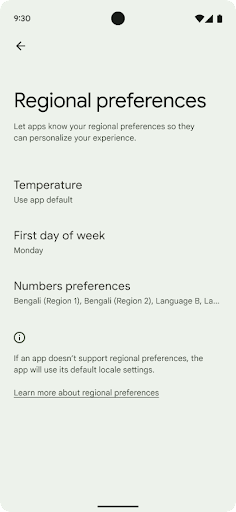
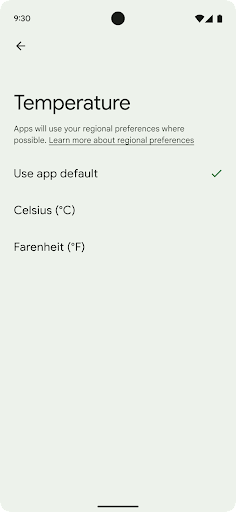
Erişilebilirlik
%200'e kadar doğrusal olmayan yazı tipi ölçeklendirme
从 Android 14 开始,系统支持字体放大高达 200%,为用户提供了其他无障碍功能选项。
为防止屏幕上的大文本元素过于放大,系统会采用非线性放大曲线。这种放大策略意味着大号文本的放大比例不会与较小的文本相同。非线性字体放大有助于保持不同大小元素之间的比例层次结构,同时缓解高级别线性文本放大存在的问题(例如文本被截断或文本因非常大的显示大小而难以阅读)。
使用非线性字体放大测试应用
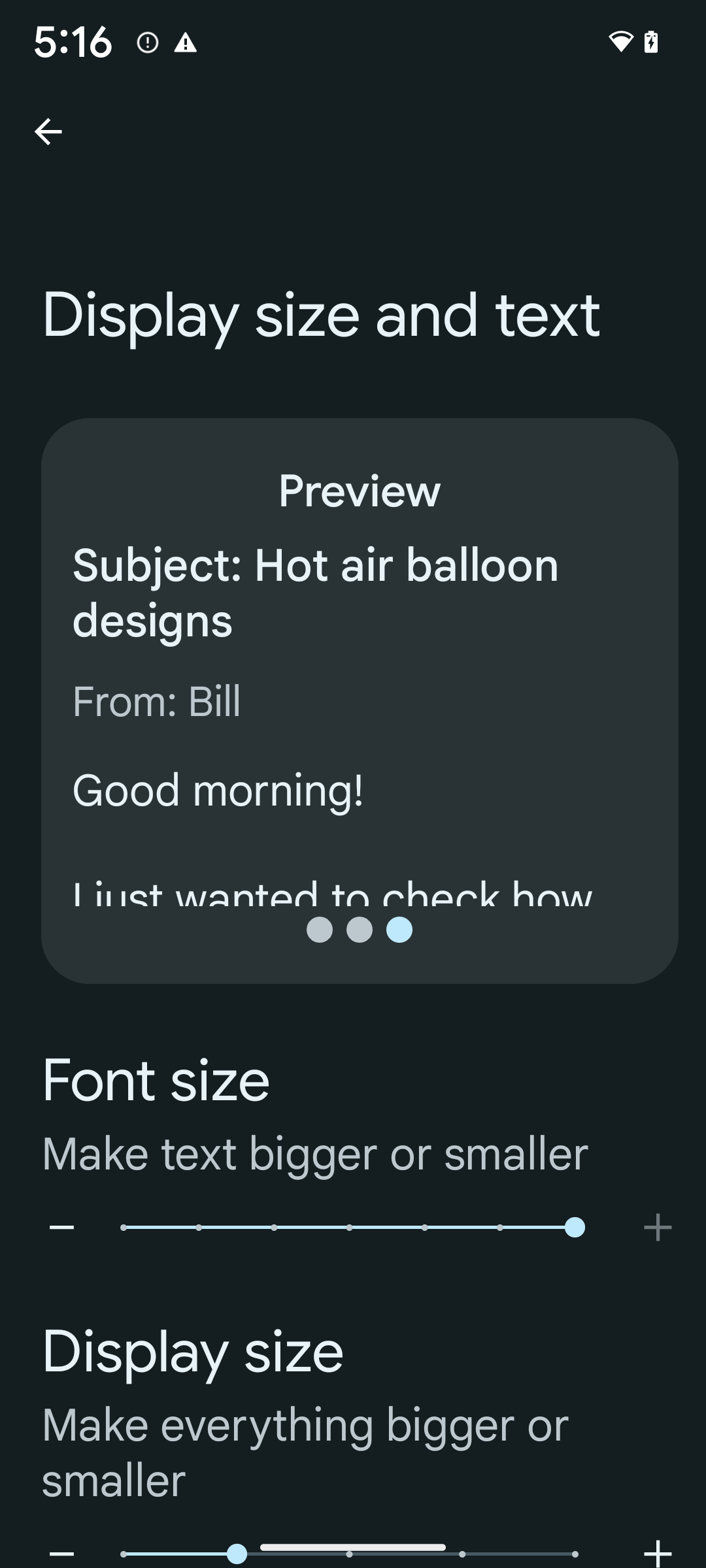
如果您已使用可缩放像素 (sp) 单位来定义文本大小,那么这些额外的选项和缩放改进会自动应用于应用中的文本。不过,您仍应在启用最大字体大小 (200%) 的情况下执行界面测试,以确保应用正确应用字体大小,并且可以容纳更大的字体大小,而不会影响易用性。
要启用 200% 字号,请按以下步骤操作:
- 打开“设置”应用,然后依次前往无障碍 > 显示大小和文字。
- 在字号选项中,点按加号 (+) 图标,直到启用最大字号设置,如本部分随附的图片所示。
针对文本大小使用放大像素 (sp) 单位
请务必始终以 sp 为单位指定文本大小。当应用使用 sp 单位时,Android 可以应用用户的首选文本大小,并相应地进行缩放。
不要为内边距使用 sp 单位,也不要定义假设存在隐式内边距的视图高度:使用非线性字体放大 sp 尺寸可能并不成比例,因此 4sp + 20sp 可能并不等于 24sp。
转换放大像素 (sp) 单位
使用 TypedValue.applyDimension() 从 sp 单位转换为像素,并使用 TypedValue.deriveDimension() 将像素转换为 sp。这些方法会自动应用适当的非线性放大曲线。
避免使用 Configuration.fontScale 或 DisplayMetrics.scaledDensity 对等式进行硬编码。由于字体放大是非线性的,因此 scaledDensity 字段不再准确。fontScale 字段应仅用于提供信息,因为字体不再使用单个标量值进行缩放。
针对 lineHeight 使用 sp 单位
请始终使用 sp 单位(而非 dp)定义 android:lineHeight,以便行高随文本一起缩放。否则,如果您的文字是 sp,但 lineHeight 是 dp 或像素,则文字不会缩放,看起来会很拥挤。
TextView 会自动更正 lineHeight,以便保留您预期的比例,但前提是 textSize 和 lineHeight 均以 sp 单位定义。
Kamera ve medya içerikleri
Resimler için Ultra HDR
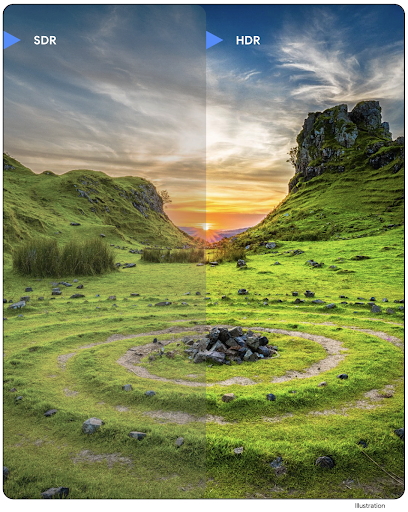
Android 14, fotoğraf çekerken sensörden daha fazla bilginin korunmasını sağlayan ve canlı renkler ile daha yüksek kontrast sağlayan Yüksek Dinamik Aralık (HDR) resimleri için destek ekler. Android, JPEG resimleriyle tamamen geriye dönük uyumlu olan Ultra HDR biçimini kullanır. Bu biçim, uygulamaların HDR resimlerle sorunsuz bir şekilde birlikte çalışmasını sağlar ve gerektiğinde resimleri Standart Dinamik Aralık (SDR) olarak gösterir.
Uygulamanız, etkinlik aralığı için HDR kullanıcı arayüzünü kullanmayı bir manifest girişi aracılığıyla veya çalışma zamanında Window.setColorMode() çağrısı yaparak etkinleştirdiğinde bu resimlerin kullanıcı arayüzünde HDR olarak oluşturulması çerçeve tarafından otomatik olarak yapılır. Desteklenen cihazlarda sıkıştırılmış Ultra HDR fotoğraflar da çekebilirsiniz. Sensörden daha fazla renk elde edildiğinde, düzenleme işlemi daha esnek olabilir. Ultra HDR resimlerle ilişkili Gainmap, OpenGL veya Vulkan kullanılarak oluşturulmak için kullanılabilir.
Kamera uzantılarında yakınlaştırma, odaklama, son görüntü ve daha fazlası
Android 14 升级并改进了相机扩展程序,让应用能够处理更长的处理时间,从而支持在受支持的设备上使用计算密集型算法(例如弱光摄影)来改善图片。这些功能可让用户在使用相机扩展功能时获得更出色的体验。这些改进的示例包括:
- 动态静态拍摄处理延迟时间估算功能可根据当前场景和环境条件提供更准确的静态拍摄延迟时间估算值。调用
CameraExtensionSession.getRealtimeStillCaptureLatency()可获取具有两种延迟时间估算方法的StillCaptureLatency对象。getCaptureLatency()方法会返回onCaptureStarted和onCaptureProcessStarted()之间的估算延迟时间,而getProcessingLatency()方法会返回onCaptureProcessStarted()和可用的最终处理帧之间的估算延迟时间。 - 支持拍摄进度回调,以便应用可以显示长时间运行的静态拍摄处理操作的当前进度。您可以检查
CameraExtensionCharacteristics.isCaptureProcessProgressAvailable是否支持此功能,如果支持,则实现onCaptureProcessProgressed()回调,并将进度(从 0 到 100)作为参数传入。 扩展程序专用元数据,例如用于调节扩展程序效果(例如背景虚化程度)的
CaptureRequest.EXTENSION_STRENGTH和EXTENSION_BOKEH。相机扩展程序中的静态图片拍摄预览功能,该功能比最终图片更快地提供经过较少处理的图片。如果扩展程序的处理延迟时间增加,可以提供 postview 图片作为占位符以提升用户体验,并在稍后改用最终图片。您可以使用
CameraExtensionCharacteristics.isPostviewAvailable检查此功能是否可用。然后,您可以将OutputConfiguration传递给ExtensionSessionConfiguration.setPostviewOutputConfiguration。支持
SurfaceView,可实现更优化且能效更高的预览渲染路径。支持在使用扩展程序时点按对焦和缩放。
Sensör içi yakınlaştırma
CameraCharacteristics içindeki REQUEST_AVAILABLE_CAPABILITIES_STREAM_USE_CASE SCALER_AVAILABLE_STREAM_USE_CASES_CROPPED_RAW içeriyorsa uygulamanız, akış kullanım alanı CameraMetadata.SCALER_AVAILABLE_STREAM_USE_CASES_CROPPED_RAW olarak ayarlanmış bir RAW hedefi içeren CaptureRequest kullanarak kırpılmış bir RAW akışına tam görüş alanı ile aynı pikselleri vermek için gelişmiş sensör özelliklerini kullanabilir.
Güncellenen kamera, istek geçersiz kılma denetimlerini uygulayarak kullanıcılara diğer kamera kontrolleri hazır olmadan önce bile yakınlaştırma kontrolü sunar.
Kayıpsız USB ses
Android 14 支持无损音频格式,可通过 USB 有线耳机提供发烧友级体验。您可以查询 USB 设备的首选混音器属性,注册监听器以监听首选混音器属性的更改,以及使用 AudioMixerAttributes 类配置混音器属性。此类表示音频混音器的格式,例如声道掩码、采样率和行为。该类允许直接发送音频,而无需混音、调节音量或处理效果。
Geliştirici üretkenliği ve araçları
Kimlik Bilgisi Yöneticisi
Android 14, platform API'si olarak Kimlik Bilgisi Yöneticisi'ni ekler. Google Play Hizmetleri'ni kullanan bir Jetpack Kitaplığı aracılığıyla Android 4.4 (API düzeyi 19) cihazlara ek destek sağlanır. Kimlik Bilgisi Yöneticisi, kimlik bilgilerini kullanıcı tarafından yapılandırılmış kimlik bilgisi sağlayıcılarla alan ve depolayan API'lerle kullanıcıların oturum açmasını kolaylaştırmayı amaçlar. Kimlik Bilgisi Yöneticisi, tek bir API'de kullanıcı adı ve şifre, geçiş anahtarları ve birleşik oturum açma çözümleri (ör. Google ile oturum açma) gibi birden fazla oturum açma yöntemini destekler.
Geçiş anahtarları birçok avantaj sağlar. Örneğin, geçiş anahtarları endüstri standartlarına göre tasarlanmıştır, farklı işletim sistemlerinde ve tarayıcı ekosistemlerinde çalışabilir, hem web sitelerinde hem de uygulamalarda kullanılabilir.
Daha fazla bilgi için Kimlik Bilgisi Yöneticisi ve geçiş anahtarları belgelerine ve Kimlik Bilgisi Yöneticisi ve geçiş anahtarları hakkındaki blog yayınına göz atın.
ve geri yükleme
Health Connect, kullanıcıların sağlık ve fitness verilerini saklayan cihaz üzerinde bir depolama alanıdır. Bu sayede kullanıcılar, en sevdikleri uygulamalar arasında veri paylaşabilir ve bu uygulamalarla hangi verileri paylaşmak istediklerini tek bir yerden kontrol edebilir.
Android 14'ten önceki Android sürümlerini çalıştıran cihazlarda Health Connect, Google Play Store'dan uygulama olarak indirilebilir. Android 14'ten itibaren Health Connect, platformun bir parçasıdır ve ayrı bir indirme işlemi gerektirmeden Google Play sistem güncellemeleri aracılığıyla güncelleme alır. Bu sayede Health Connect sık sık güncellenebilir ve uygulamalarınız, Health Connect'in Android 14 veya sonraki sürümleri çalıştıran cihazlarda kullanılabildiğinden emin olabilir. Kullanıcılar, sistem ayarlarına entegre edilmiş gizlilik denetimleriyle cihazlarındaki Ayarlar'dan Health Connect'e erişebilir.
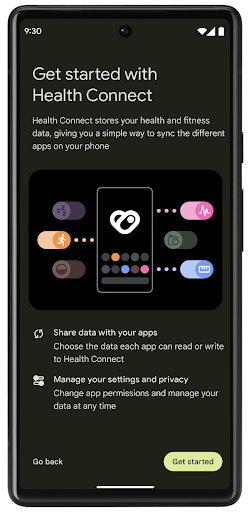
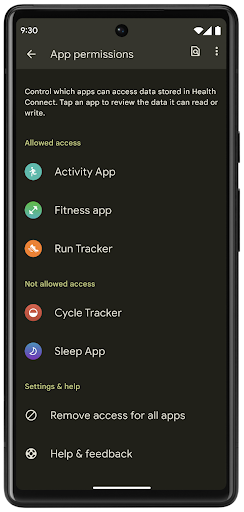
Health Connect, Android 14'te egzersiz rotaları gibi çeşitli yeni özellikler içerir. Bu özellikler sayesinde kullanıcılar, egzersiz rotalarını harita üzerinde görselleştirerek paylaşabilir. Rota, belirli bir zaman aralığında kaydedilen konumların listesi olarak tanımlanır. Uygulamanız, rotaları egzersiz oturumlarına ekleyerek bunları birbirine bağlayabilir. Kullanıcıların bu hassas veriler üzerinde tam kontrole sahip olması için kullanıcıların, rotaların tek tek diğer uygulamalarla paylaşılmasına izin vermesi gerekir.
Daha fazla bilgi için Health Connect dokümanlarına ve Android Sağlık'ta yenilikler başlıklı blog yayınına göz atın.
OpenJDK 17 güncellemeleri
Android 14, Android'in temel kitaplıklarını en son OpenJDK LTS sürümlerindeki özelliklerle uyumlu hale getirmek için yenileme çalışmalarına devam ediyor. Bu çalışmalara hem kitaplık güncellemeleri hem de uygulama ve platform geliştiricileri için Java 17 dil desteği dahildir.
Aşağıdaki özellikler ve iyileştirmeler dahildir:
- Yaklaşık 300
java.basesınıfı Java 17 desteği için güncellendi. - Java programlama diline çok satırlı dize değişmezleri getiren metin blokları.
- instanceof için kalıp eşleştirme: Bir nesnenin
instanceofiçinde ek değişkenler olmadan belirli bir türe sahipmiş gibi değerlendirilmesine olanak tanır. - Hangi sınıfların ve arayüzlerin bunları genişletebileceğini veya uygulayabileceğini kısıtlamanıza olanak tanıyan mühürlü sınıflar.
Google Play sistem güncellemeleri (Mainline projesi) sayesinde 600 milyondan fazla cihaz, bu değişiklikleri içeren en son Android Runtime (ART) güncellemelerini alabilir. Bu, uygulamalara cihazlar genelinde daha tutarlı ve güvenli bir ortam sunma ve kullanıcılara platform sürümlerinden bağımsız olarak yeni özellikler ve özellikler sunma taahhüdümüzün bir parçasıdır.
Java ve OpenJDK, Oracle ve/veya satış ortaklarının ticari markaları ya da tescilli ticari markalarıdır.
Uygulama mağazalarıyla ilgili iyileştirmeler
Android 14 引入了多个 PackageInstaller API,可帮助应用商店改善其用户体验。
下载之前请求批准安装
安装或更新应用可能需要用户批准。例如,当使用 REQUEST_INSTALL_PACKAGES 权限的安装程序尝试安装新应用时。在之前的 Android 版本中,只有在将 APK 写入安装会话并且提交会话后,应用商店才能请求用户批准。
从 Android 14 开始,requestUserPreapproval() 方法可让安装程序在提交安装会话之前请求用户批准。此项改进可让应用商店将任何 APK 的下载操作推迟到用户批准安装之后。此外,用户批准安装后,应用商店可以在后台下载并安装应用,而不会干扰用户。
承担未来更新的责任
借助 setRequestUpdateOwnership() 方法,安装程序可以向系统表明它打算负责将被安装的应用未来的更新。此 capability 可实现更新所有权强制执行,即仅允许更新所有者为应用安装自动更新。更新所有权强制执行有助于确保用户仅收到来自预期应用商店的更新。
任何其他安装程序(包括使用 INSTALL_PACKAGES 权限的安装程序)都必须获得用户的明确批准,才能安装更新。如果用户决定继续从其他来源安装更新,则会失去更新所有权。
在干扰较少的时段更新应用
应用商店通常希望避免更新正在使用的应用,因为这会导致应用正在运行的进程被终止,而这可能会中断用户正在执行的操作。
从 Android 14 开始,InstallConstraints API 让安装程序可以确保其应用更新在适当的时机进行。例如,应用商店可以调用 commitSessionAfterInstallConstraintsAreMet() 方法来确保仅在用户不再与相应应用互动时才进行更新。
无缝安装可选拆分
借助拆分 APK,应用的功能可以通过单独的 APK 文件提供,而不是以单体式 APK 的形式提供。借助拆分 APK,应用商店可以优化不同应用组件的提供。例如,应用商店可能会根据目标设备的属性进行优化。自在 API 级别 22 中引入以来,PackageInstaller API 一直支持拆分。
在 Android 14 中,setDontKillApp() 方法可让安装程序指明在安装新的拆分项时应用的运行进程不应终止。应用商店可以使用此功能,在用户使用应用时无缝安装应用的新功能。
Uygulama meta verileri paketleri
Android 14'ten itibaren Android paket yükleyici, Google Play gibi uygulama mağazası sayfalarına dahil edilecek uygulama meta verilerini (ör. veri güvenliği uygulamaları) belirtmenize olanak tanır.
Kullanıcıların cihaz ekran görüntüsü aldığını algılama
Android 14, ekran görüntülerinin algılanması için daha standart bir deneyim oluşturmak amacıyla gizliliği korumaya yönelik bir ekran görüntüsü algılama API'si sunuyor. Bu API, uygulamaların etkinlik bazında geri çağırma işlevleri kaydetmesine olanak tanır. Bu geri çağırmalar, kullanıcı bu etkinlik görünürken ekran görüntüsü aldığında çağrılır ve kullanıcı bilgilendirilir.
Kullanıcı deneyimi
Paylaşım sayfasındaki özel işlemler ve iyileştirilmiş sıralama
Android 14 更新了系统 Sharesheet,以便为用户提供自定义应用操作和信息更丰富的预览结果。
添加自定义操作
对于 Android 14,您的应用可以向其调用的系统 Sharesheet 添加自定义操作。
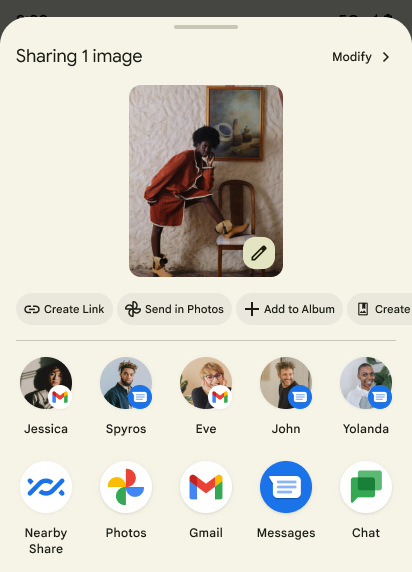
提高直接共享目标的排名
Android 14 根据来自应用的更多信号来确定直接共享目标的排名,以便为用户提供更实用的结果。为了提供最实用的排名信号,请遵循提高直接共享目标排名的准则。通讯应用还可以报告出站和入站消息的快捷方式使用情况。
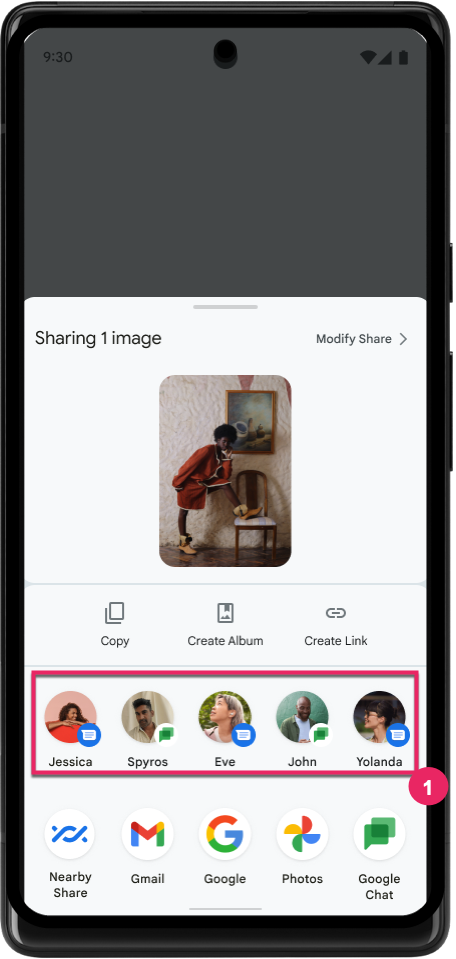
Tahmine dayalı geri hareketi için yerleşik ve özel animasyon desteği
Android 13, geliştirici seçeneğiyle birlikte tahmine dayalı ana sayfaya geri gitme animasyonunu kullanıma sundu. Geliştirici seçeneği etkinleştirilmiş desteklenen bir uygulamada geri kaydırılırken, geri hareketinin uygulamadan çıkıp ana ekrana döndüğünü belirten bir animasyon gösterilir.
Android 14, Tahmini Geri özelliği için birden fazla iyileştirme ve yeni rehberlik içerir:
android:enableOnBackInvokedCallback=trueayarını, uygulamanın tamamı yerine etkinlik başına tahmine dayalı geri sistem animasyonlarını etkinleştirmek için ayarlayabilirsiniz.- Android 13'teki ana sayfaya geri gitme animasyonuna eşlik edecek yeni sistem animasyonları ekledik. Yeni sistem animasyonları, etkinlik ve görevler arasıdır ve Tahmine Dayalı Geri Gitme'ye geçtikten sonra otomatik olarak sunulur.
- Alt sayfalar, yan sayfalar ve Arama için yeni Material bileşen animasyonlarını ekledik.
- Özel uygulama içi animasyonlar ve geçişler oluşturmak için tasarım kılavuzu hazırladık.
- Özel uygulama içi geçiş animasyonlarını desteklemek için yeni API'ler ekledik:
handleOnBackStarted,handleOnBackProgressed,handleOnBackCancelledinOnBackPressedCallbackonBackStarted,onBackProgressed,onBackCancelledinOnBackAnimationCallback- Kullanıcı geri kaydırdığında yanıt veren geçişler için
overridePendingTransitionyerineoverrideActivityTransitionkullanın.
Bu Android 14 önizleme sürümünde, Tahmini Geri Yükleme'nin tüm özellikleri geliştirici seçeneği olarak sunulur. Uygulamanızı tahmini geriye taşıma ile ilgili geliştirici kılavuzunu ve özel uygulama içi geçişler oluşturma ile ilgili geliştirici kılavuzunu inceleyin.
Büyük ekranlı cihaz üreticilerinin uygulama başına geçersiz kılmaları
借助按应用替换项,设备制造商可以更改应用在大屏设备上的行为。例如,FORCE_RESIZE_APP 替换项会指示系统调整应用大小以适应显示屏尺寸(避免进入尺寸兼容模式),即使在应用清单中设置了 resizeableActivity="false" 也是如此。
替换项旨在改善大屏设备上的用户体验。
借助新的清单属性,您可以为应用停用某些设备制造商替换项。
Büyük ekran kullanıcıları için uygulama başına geçersiz kılmalar
按应用替换项会更改应用在大屏设备上的行为。例如,无论应用的配置如何,OVERRIDE_MIN_ASPECT_RATIO_LARGE 设备制造商替换项都会将应用宽高比设置为 16:9。
借助 Android 14 QPR1,用户可以在大屏设备上通过新的设置菜单应用按应用替换项。
Uygulama ekran paylaşımı
借助应用界面共享功能,用户可以在录制屏幕内容时共享应用窗口,而不是整个设备屏幕。
在应用屏幕共享模式下,状态栏、导航栏、通知和其他系统界面元素会从共享显示屏中排除。系统只会分享所选应用的内容。
应用屏幕共享功能可让用户运行多个应用,但将内容共享限制为单个应用,从而提高工作效率并保护隐私。
Pixel 8 Pro'da Gboard'da LLM destekli Akıllı Yanıt
Aralık ayı özellik güncellemesini alan Pixel 8 Pro cihazlarda geliştiriciler, Google Tensor'da çalışan cihaz üzerinde büyük dil modelleri (LLM) tarafından desteklenen Gboard'da daha yüksek kaliteli akıllı yanıtları deneyebilir.
Bu özellik, WhatsApp, Line ve KakaoTalk'ta ABD İngilizcesi için sınırlı bir önizleme olarak sunulmaktadır. Klavyeniz olarak Gboard'u kullanan bir Pixel 8 Pro cihaz kullanmanız gerekir.
Bu özelliği denemek için önce Ayarlar > Geliştirici Seçenekleri > AICore Ayarları > Aicore Kalıcı'yı Etkinleştir'i seçerek özelliği etkinleştirin.
Ardından, desteklenen bir uygulamada bir ileti dizisi açın. Gboard'un öneri şeridinde, gelen iletilere yanıt olarak LLM destekli Akıllı Yanıt'ı görebilirsiniz.
Grafik
Yollar sorgulanabilir ve enterpolasyon yapılabilir
Android 的 Path API 是一种强大且灵活的机制,可用于创建和渲染矢量图形,能够描边或填充路径、根据线段或二次曲线或立方曲线构建路径、执行布尔运算以获取更复杂的形状,或同时执行所有这些操作。但有一个限制是,您无法了解 Path 对象中实际包含的内容;该对象的内部信息在创建后对调用方是不透明的。
如需创建 Path,您可以调用 moveTo()、lineTo() 和 cubicTo() 等方法来添加路径段。但是,无法询问该路径有哪些片段,因此您必须在创建时保留该信息。
从 Android 14 开始,您可以查询路径以了解其内部内容。首先,您需要使用 Path.getPathIterator API 获取 PathIterator 对象:
Kotlin
val path = Path().apply { moveTo(1.0f, 1.0f) lineTo(2.0f, 2.0f) close() } val pathIterator = path.pathIterator
Java
Path path = new Path(); path.moveTo(1.0F, 1.0F); path.lineTo(2.0F, 2.0F); path.close(); PathIterator pathIterator = path.getPathIterator();
接下来,您可以调用 PathIterator 逐个遍历片段,并检索每个片段的所有必要数据。以下示例使用了 PathIterator.Segment 对象,它会为您打包数据:
Kotlin
for (segment in pathIterator) { println("segment: ${segment.verb}, ${segment.points}") }
Java
while (pathIterator.hasNext()) { PathIterator.Segment segment = pathIterator.next(); Log.i(LOG_TAG, "segment: " + segment.getVerb() + ", " + segment.getPoints()); }
PathIterator 还有一个非分配版 next(),您可以在其中传入缓冲区来保存点数据。
查询 Path 数据的一个重要用例是插值。例如,您可能想在两个不同的路径之间添加动画(或变形)。为了进一步简化该用例,Android 14 针对 Path 还包含 interpolate() 方法。假设两个路径具有相同的内部结构,interpolate() 方法会使用该插值结果创建一个新的 Path。以下示例返回了一个形状介于 path 和 otherPath 之间的一半(线性插值为 0.5)的路径:
Kotlin
val interpolatedResult = Path() if (path.isInterpolatable(otherPath)) { path.interpolate(otherPath, .5f, interpolatedResult) }
Java
Path interpolatedResult = new Path(); if (path.isInterpolatable(otherPath)) { path.interpolate(otherPath, 0.5F, interpolatedResult); }
Jetpack graphics-path 库也为早期版本的 Android 启用了类似的 API。
Köşe ve parça gölgelendiricileri içeren özel ağlar
Android 长期以来一直支持使用自定义着色绘制三角网格,但输入网格格式仅限于一些预定义的属性组合。Android 14 增加了对自定义网格的支持,可将其定义为三角形或三角形条,并且可以选择是否编入索引。这些网格是使用自定义属性、顶点步长、可变以及使用 AGSL 编写的顶点着色器和片段着色器指定的。
顶点着色器定义了位置和颜色等变量,而片段着色器可以选择为像素定义颜色,通常是使用顶点着色器创建的变量。如果片段着色器提供颜色,则系统会使用绘制网格时选择的混合模式将其与当前 Paint 颜色混合。Uniform 可以传递到片段着色器和顶点着色器,以提高灵活性。
Canvas için donanım arabelleği oluşturucu
协助使用 Android 的 Canvas API 通过
硬件加速至 HardwareBuffer、Android 14
引入了 HardwareBufferRenderer。如果您的用例涉及通过 SurfaceControl 与系统合成器通信以实现低延迟绘制,此 API 特别有用。

